Ukrainian parliamentary election, 2007
|
||||||
|
|
||||||
| All 450 seats to the Verkhovna Rada of Ukraine | ||||||
|---|---|---|---|---|---|---|
| First party | Second party | Third party | ||||
 |
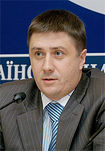 |
|||||
| Leader | Viktor Yanukovych | Yulia Tymoshenko | Vyacheslav Kyrylenko | |||
| Party | Party of Regions | Yulia Tymoshenko Bloc | Our Ukraine | |||
| Leader since | 13 April 2003 | 9 February 2001 | 5 July 2007 | |||
| Last election | 186 seats, 32.14% | 129 seats, 22.29% | 81 seats, 13.95% | |||
| Seats won | 175 | 156 | 72 | |||
| Seat change | -11 | +27 | -9 | |||
| Popular vote | 8,013,895 | 7,162,193 | 3,301,282 | |||
| Percentage | 34.37% | 30.71% | 14.15% | |||
| Swing | +2.23% | +8.62% | +0.20% | |||
|
|
||||||
| Fourth party | Fifth party | |||||
 |
 |
|||||
| Leader | Petro Symonenko | Volodymyr Lytvyn | ||||
| Party | Communist Party of Ukraine | Lytvyn Bloc | ||||
| Leader since | 1993 | 2005 | ||||
| Last election | 21 seats, 3.66% | 0 seats, 2,44% | ||||
| Seats won | 27 | 20 | ||||
| Seat change | +6 | +20 | ||||
| Popular vote | 1,257,291 | 924,538 | ||||
| Percentage | 5.39% | 3.96% | ||||
| Swing | +1.73% | +1.52% | ||||
|
|
||||||
| Results of the 2007 parliamentary election. | ||||||
|
|
||||||
|
||||||
Early parliamentary elections in Ukraine took place on 30 September 2007. The date of the election was determined following agreement between the President Viktor Yushchenko, the Prime Minister Viktor Yanukovych and the Chairman of the Verkhovna Rada (Ukrainian Parliament) Oleksandr Moroz on 27 May 2007, in an attempt to resolve the political crisis in Ukraine triggered by the 2 April 2007 presidential decree on dissolution of Ukraine's parliament. [1][2]
According to Ukraine's electoral system, the 450 seats are divided among all parties that achieved a minimum 3% nationwide vote tally. The number of seats that are allocated to each party, above the 3% participation rate quota, is calculated using the Hamilton method of apportionment.[3]
In the election, an alliance of two electoral blocs associated with the Orange Revolution, Yulia Tymoshenko's Bloc (BYuT) and Our Ukraine-Peoples Self Defence (OU-PSD) obtained a narrow majority [4] leaving their main rival, the Party of Regions (PoR) in opposition.
Contents |
Political crisis
| Ukraine |
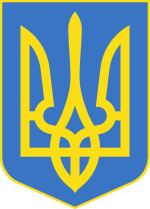 This article is part of the series: |
|
|
|
|
Other countries · Atlas |
Following the 2006 parliamentary elections, there was an ongoing power struggle between the President and the parliamentary majority, which resulted in the dissolution of parliament.[5] The majority in the parliament, know as Coalition of National Unity, was formed by Party of Regions, Communist Party, and Socialist Party). It was opposed by Yulia Tymoshenko Bloc and Our Ukraine.
Early in 2007, several members of the opposition indicated their support to the ruling coalition. If sufficient numbers of members of parliament supported the government, the Coalition of National Unity could have secured a two-thirds majority, empowering the parliament to override the president's right of veto and enabling the parliament to initiate limited constitutional changes.
On 2 April 2007, Yushchenko decreed the dissolution of the Verkhovna Rada.[6]
The authority of the president to dismiss the parliament was challenged in the Constitutional Court,[7][8] however following the president's intervention in the operation of the Constitutional Court the court has not ruled on the constitutionality of the president's decree. [9][10][11][12][13][14] [15]
The election was originally scheduled to be held on 27 May 2007 and later postponed to 24 June 2007. On 27 May 2007 an agreement was signed by President Viktor Yushchenko, Prime Minister Viktor Yanukovych, and Parliamentary Speaker Oleksandr Moroz, scheduling the elections to be held on 30 September 2007. [16]
The President's previous decrees were revoked and a new decree based on the provisions of Article 82 and Article 90 of Ukraine's Constitution was issued in its place in August 2007 following the resignation of over 150 members of the opposition parties.
Results
The first polling places to open were at the Ukrainian embassies in Australia and Japan. Election districts were open from 7:00AM until 10:00PM local time. According to the Central Election Commission of Ukraine 63.22% of registered voters cast ballots.[17] This easily exceeded the 50% participation required by Ukrainian law to make the election valid.
Five parties received the required election threshold of 3% of the total vote and entered the Verkhovna Rada: Party of Regions (PoR), Bloc Yulia Tymoshenko (BYuT), Our Ukraine-Peoples Self Defence (OU-PSD), the Communist Party of Ukraine (CPU) and the Bloc Lytvyn (BL). The Socialist Party of Ukraine (SPU) secured only 2.86% of the vote and as such did not win any seats in the new parliament. Had the Socialist Party received an additional 0.14% of the vote the overall results would have been more or less the same as the previous Ukrainian parliamentary election in 2006 with the addition of Bloc Lytvyn representatives.
Election results by parties and blocs
| Parties and blocs | Votes | % | Swing % | Seats | |
|---|---|---|---|---|---|
| Party of Regions (Партія регіонів) | 8,013,895 | 34.37 | 175 | ||
Yulia Tymoshenko Bloc (Блок Юлії Тимошенко)
|
7,162,193 | 30.71 | 156 | ||
Our Ukraine–People's Self-Defense Bloc (Блок Наша Україна–Народна Самооборона)
|
3,301,282 | 14.15 | 72 | ||
| Communist Party of Ukraine (Комуністична партія України) | 1,257,291 | 5.39 | 27 | ||
Lytvyn Bloc (Блок Литвина)
|
924,538 | 3.96 | 20 | ||
| Socialist Party of Ukraine (Соціалістична партія України) | 668,234 | 2.86 | |||
| Progressive Socialist Party of Ukraine (Прогресивна соціалістична партія України) | 309,008 | 1.32 | |||
| All-Ukrainian Union "Freedom" (Всеукраїнське об'єднання "Свобода") | 178,660 | 0.76 | |||
| Party of Greens of Ukraine (Партія Зелених України) | 94,505 | 0.40 | |||
Electoral Bloc of Liudmyla Suprun – Ukrainian Regional Asset (Виборчий блок Людмили Супрун — Український регіональний актив)
|
80,944 | 0.34 | |||
| Communist Party of Ukraine (renewed) (Комуністична партія України (оновлена)) | 68,602 | 0.29 | |||
| Party of Free Democrats (Партія Вільних Демократів) | 50,852 | 0.21 | |||
Bloc of the Party of Pensioners of Ukraine (Блок партії пенсіонерів України)
|
34,845 | 0.14 | |||
| Party of National Economic Development of Ukraine (Партія національно-економічного розвитку України) | 33,489 | 0.14 | |||
Ukrainian People's Bloc (Український Народний Блок)
|
28,414 | 0.12 | |||
Peasants' Bloc "Agrarian Ukraine" (Селянський Блок "Аграрна Україна")
|
25,675 | 0.11 | |||
Christian Bloc (Християнський блок)
|
24,597 | 0.10 | |||
Electoral Bloc of Political Parties "KUCHMA" (Виборчий блок політичних партій «КУЧМА»)
|
23,676 | 0.10 | |||
Bloc "All-Ukrainian Community" (Блок "Всеукраїнська громада")
|
12,327 | 0.05 | |||
| All-Ukrainian Party of People's Trust (Всеукраїнська партія Народної Довіри) | 5,342 | 0.02 | |||
| Against all | 637,185 | 2.73 | |||
| Invalid ballot papers | 379,658 | 1.62 | |||
| Total (turnout 62.02%) | 23,315,257 | 100 | 450 | ||
| Source: Central Election Commission of Ukraine (English) More detailed information: Центральної виборчої комісії України (Ukrainian) | |||||
There were 20 parties and blocs registered on the voting ballot. One more electoral bloc PORA-Reforms and Order was participating in early election procedures but was subsequently removed by CVK as result of court decision.[18] Number 17 assigned initially to this bloc was removed from the ballot paper.
|
|
|
|
|
Support of leading parties and blocs by administrative regions
| Region | Voter registration | Voter turnout | PoR | BYuT | OU-PSD | CPU | BL | SPU |
|---|---|---|---|---|---|---|---|---|
| Autonomous Republic of Crimea | 1,568,070 | 55.8 | 61.0 | 6.9 | 8.2 | 7.6 | 3.9 | 1.9 |
| Cherkasy Oblast | 1,095,058 | 60.1 | 15.5 | 47.0 | 15.3 | 4.9 | 4.9 | 4.3 |
| Chernihiv Oblast | 939,072 | 61.8 | 20.7 | 41.9 | 14.9 | 6.7 | 4.2 | 2.9 |
| Chernivtsi Oblast | 705,272 | 58.2 | 16.8 | 46.2 | 20.3 | 2.3 | 2.5 | 3.8 |
| Dnipropetrovsk Oblast | 2,810,168 | 58.9 | 48.7 | 20.8 | 6.2 | 7.6 | 5.0 | 1.3 |
| Donetsk Oblast | 3,620,888 | 66.0 | 76.0 | 4.5 | 2.0 | 6.8 | 1.0 | 1.3 |
| Ivano-Frankivsk Oblast | 1,080,296 | 72.6 | 3.0 | 50.7 | 36.8 | 0.8 | 1.0 | 0.8 |
| Kharkiv Oblast | 2,282,993 | 58.3 | 49.6 | 16.4 | 8.1 | 8.3 | 4.6 | 2.6 |
| Kherson Oblast | 893,442 | 55.5 | 43.2 | 23.1 | 9.1 | 9.1 | 3.7 | 2.5 |
| Khmelnytsky Oblast | 1,083,968 | 66.3 | 14.1 | 48.2 | 18.4 | 4.0 | 6.6 | 1.7 |
| Kirovohrad Oblast | 614,832 | 57.9 | 27.0 | 37.6 | 11.7 | 6.4 | 5.5 | 2.8 |
| Kiev | 2,151,576 | 63.5 | 15.0 | 46.2 | 15.8 | 4.6 | 6.6 | 1.6 |
| Kiev Oblast | 1,679,197 | 61.9 | 13.0 | 53.4 | 15.1 | 3.0 | 5.1 | 2.2 |
| Luhansk Oblast | 1,898,637 | 66.3 | 73.5 | 5.1 | 1.7 | 8.5 | 2.4 | 1.3 |
| Lviv Oblast | 2,002,372 | 73.9 | 4.2 | 50.4 | 36.0 | 1.0 | 1.1 | 0.6 |
| Mykolaiv Oblast | 971,038 | 57.6 | 54.4 | 16.6 | 5.8 | 7.2 | 4.5 | 1.9 |
| Odessa Oblast | 1,851,868 | 54.5 | 52.2 | 13.7 | 6.5 | 6.2 | 5.1 | 7.2 |
| Poltava Oblast | 1250,952 | 61.9 | 24.8 | 37.9 | 14.5 | 6.5 | 4.9 | 3.0 |
| Rivne Oblast | 865,092 | 68.7 | 10.4 | 51.0 | 20.8 | 2.4 | 6.1 | 2.1 |
| Sevastopol | 308,928 | 59.7 | 64.5 | 5.0 | 2.3 | 10.3 | 2.5 | 2.7 |
| Sumy Oblast | 990,575 | 62.0 | 15.7 | 44.5 | 20.8 | 5.8 | 3.3 | 2.0 |
| Ternopil Oblast | 870,214 | 76.5 | 3.0 | 51.6 | 35.2 | 0.7 | 1.6 | 1.1 |
| Vinnytsia Oblast | 1,342,608 | 64.5 | 12.6 | 50.0 | 18.6 | 5.0 | 3.1 | 2.5 |
| Volyn Oblast | 801,557 | 71.0 | 6.7 | 57.6 | 20.0 | 2.7 | 4.6 | 1.9 |
| Zakarpattia Oblast | 946,525 | 52.1 | 19.8 | 28.9 | 31.1 | 1.8 | 6.0 | 3.5 |
| Zhytomyr Oblast | 1,044,852 | 62.5 | 22.4 | 37.0 | 15.1 | 5.8 | 8.3 | 2.5 |
| Zaporizhia Oblast | 1,515,832 | 61.4 | 55.5 | 14.7 | 4.7 | 8.3 | 5.5 | 2.3 |
| Foreign Embassies | 431,142 | 6.0 | 26.5 | 33.1 | 25.5 | 1.6 | 2.3 | 1.2 |
| Ukraine | 37,185,882 | 62.0 | 34.4 | 30.7 | 14.2 | 5.4 | 4.0 | 2.9 |
Format of ruling coalition
Following the announcement of preliminary election results, the parties expressed their position on forming the coalition. The Party of Regions announced itself a winner of the election and stated that it started negotiations on forming a ruling coalition. The party did not express the desire to be in opposition. Tymoshenko's Bloc advocated a coalition with Our Ukraine and possibly Lytvyn's Bloc. Yulia Tymoshenko was strongly against any coalition with the Party of Regions or the Communists. She stated that her Bloc would be in opposition should such a coalition be formed. President Yushchenko has expressed the need for a better relationship between coalition and opposition. This should be achieved by providing the opposition with posts in the parliament and the government. Lytvyn's Bloc received proposals from all top parties on forming a coalition. Leaders of the Bloc stated that their decision will be made at the party's assembly. Oleksandr Moroz, the leader of the Socialist Party of Ukraine, acknowledged his defeat on 4 October 2007 and supported Tymoshenko's bid for premiership.[19]
Yulia Tymoshenko, following the formation of a coalition between the Yulia Tymoshenko Bloc and Our Ukraine–People's Self-Defense Bloc was subsequently elected prime-minister on 18 December 2007.[4] Her candidacy was supported by the vote of 226 deputies.[20]
The Verkhovna Rada of Ukraine is competent on the condition that no less than two-thirds of its constitutional composition has been elected. This means that if any one of the two largest parties resign en masse, the parliament would lose its authority and fresh elections would be required.
International observers
3354 international observers were officially registered to monitor the conduct of the election.[21]
Representatives of the Council of Europe, the Organization for Security and Co-operation in Europe (OSCE) and Fair Election organization registered officials with the Central Elections Committee. The OSCE closely worked with Ukrainian officials in the design, administration, and conduct of the election.
Observers declared that elections generally met international standards for democratic elections. However they noted:[22][23][24]
- delays in the formation of district and precinct election commissions
- the inadequate quality of voter lists
- possible disenfranchisement of voters due to law amendments on:
- abolishment of absentee ballots
- removing from lists voters who have crossed the state border after 1 August 2007.
- modalities for voting at home
- extensive campaigning by state and local officials from all sides in violation of law.
Exit polls
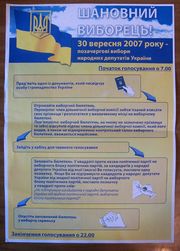

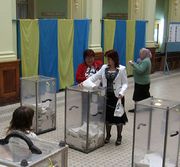
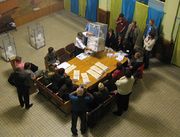
| Party | National Exit Poll [1] [2] | Sotsiovymir [3] | Ukrainian Exit Poll [4] | Public Strategies [5] |
|---|---|---|---|---|
| Party of Regions | 35.3 | 33.9 | 34.9 | 34.5 |
| Yulia Tymoshenko Electoral Bloc | 31.5 | 32.5 | 32.4 | 30.4 |
| Our Ukraine–People's Self-Defense Bloc | 13.5 | 14.7 | 14.1 | 14.4 |
| Communist Party of Ukraine | 5.1 | 4.4 | 4.5 | 5.2 |
| Lytvyn's Bloc | 3.8 | 4.0 | 3.8 | 4.0 |
| Socialist Party of Ukraine | 2.5 | 2.4 | 2.1 | - |
| Progressive Socialist Party of Ukraine | 1.5 | - | - | - |
| Other parties and blocs | 3.9 | - | - | - |
| Against all | 2.9 | 2.8 | 3.0 | - |
Time Table
- August 2 - Commencement of Official Campaign
- August 3 - The Central Election Commission of Ukraine (CVK) is to make decision about giving an airtime for blocs and parties at the budget expense
- August 4 - The CVK must hold a draw to establish broadcast priorities; Deadline for setting of the ballot’s form and text
- August 14 - The CVK has to prepare information placards of election participants and send them to district election commissions
- August 22 - Ballots papers to be submitted for printing
- August 24 - Close of Registration by Foreign Observers
- August 25 - Close of Party List nominations; State television and radio broadcasters should submit a schedule of parties and bloc’s commercial
- August 28 - CVK verification of nominations finalized
- August 30 - Party and Block registration documentation deadline; Close of registration for civil organizations to petition for participation of official observers
- September 2 - Official publication of Election List
- September 26 - Border Services to submit list of Ukrainian Citizens who have left the country and have not returned
- September 30 - Parliamentary Elections
- October 15 - Preliminary announcement of election results
- October 20 - Official final announcement of election results
Registered parties and blocs
Number in parentheses is the number of candidates included on the party list. Parties or blocs that obtained 3% or more of the vote are in bold.
|
|
References
- ↑ "Ukraine leaders agree on poll date". Secretariat of President of Ukraine. 2007-05-27. http://www.president.gov.ua/en/news/data/1_16140.html.
- ↑ "Ukraine leaders sign joint statement". 2007-05-27. http://en.for-ua.com/news/2007/05/29/101029.html.
- ↑ Laws of Ukraine. Law No. 1665-IV: On elections of People's deputies of Ukraine. Passed on 2004-03-25. (Ukrainian). Article 96.
- ↑ 4.0 4.1 "Orange bloc edges to poll victory". BBC News. 2007-10-03. http://news.bbc.co.uk/2/hi/europe/7025382.stm. Retrieved 2007-10-03.
- ↑ "President dissolves parliament". Press office of President Victor Yushchenko. 2007-04-02. http://www.president.gov.ua/en/news/data/1_14702.html.
- ↑ "Tragedy and farce". The Economist. 2007-04-04. http://www.economist.com/world/europe/displaystory.cfm?story_id=8975348.
- ↑ "Legal Opinion with regard to the results of legal examination of Decree of the President of Ukraine dated April, 2 the year 2007 N 264 “On pre-term abatement of authority of the Verkhovna Rada of Ukraine”" (in English) (DOC). Ministry of Justice Ukraine. http://www.minjust.gov.ua/files/The_Legal_Opinion_of_the_Ministry_of_Justice.rtf.
- ↑ PACE (2007-04-19). "Functioning of democratic institutions in Ukraine" (in English). PACE. http://assembly.coe.int/Mainf.asp?link=/Documents/AdoptedText/ta07/ERES1549.htm.
- ↑ "Constitutional Court Judge Havrysh Doubts Constitutional Court Will Consider Petition On Constitutionality Of September 30 Rada Elections" (in English). Ukrainian News agency. 2007-07-24. http://www.ukranews.com/eng/article/56286.html.
- ↑ "Lavrynovych: Early elections should have been already recognized invalid today" (in English). Inter-Media, ForUm. 2007-08-03. http://en.for-ua.com/news/2007/08/03/161518.html.
- ↑ "Stanik Back Into the CC" (in English). http://www.pravda.com.ua/en/news/2007/7/20/8377.htm. Retrieved 2006-07-20.
- ↑ "Yushchenko dismissed CCU judges" (in English). for-ua. http://www.eng.for-ua.com/news/2007/05/03/103007.html. Retrieved 2006-05-17.
- ↑ "Stanik and Pshenychnyy returned to CC". Korrespondent. 2007-05-17. http://www.korrespondent.net/main/190075.
- ↑ "Yushchenko dismissed CCU judges" (in English). for-ua. http://www.eng.for-ua.com/news/2007/05/03/103007.html. Retrieved 2006-05-17.
- ↑ "Supreme Court Restores Stanik As Constitutional Court Judge" (in English). Ukrainian News agency. 2008-03-27. http://www.ukranews.com/eng/article/112528.html.
- ↑ "Ukraine leaders sign joint statement" (in English). ForUm. 2007-05-29. http://en.for-ua.com/news/2007/05/29/101029.html.
- ↑ "First CVK result" (in Ukrainian). Pravda. 2007-10-01. http://pravda.com.ua/news/2007/10/1/64710.htm. Retrieved 2007-10-01.
- ↑ "Regulation №307" (in Ukrainian). Central Election Commission of Ukraine. 2007-09-04. http://www.cvk.gov.ua/postanovy/2007/p0307_2007.htm.
- ↑ Bondaruk, Halyna (2007-10-04). "Moroz Recognizes Defeat and Stands for Tymoshenko’s Premiership". Ukrayinska Pravda. http://www2.pravda.com.ua/en/news/2007/10/4/9121.htm.
- ↑ "Parliament named Tymoshenko as the Prime Minister of Ukraine" (in Russian). Korrespondent. December 18, 2007. http://korrespondent.net/ukraine/politics/319536. Retrieved 2007-12-18.
- ↑ "International observers". Central Election Commission of Ukraine. 2007-10-17. http://www.cvk.gov.ua/vnd2007/w6p041pt001f01=600.html.
- ↑ "Ukraine’s Pre-Term Parliamentary Elections and Demonstrable Commitment to Democratic Standards focus of Commission Initiatives". Commission on Security and Cooperation in Europe. 2007-12-06. http://www.csce.gov/index.cfm?Fuseaction=UserGroups.Home&ContentRecord_id=131&ContentType=G.
- ↑ "OSCE/ODIHR Election Observation Mission Report" (PDF). Organization for Security and Co-operation in Europe. 2007-12-20. http://www.osce.org/documents/odihr/2007/12/29054_en.pdf.
- ↑ "Final report on 2007 parliamentary elections in Ukraine". European Network of Election Monitoring Organizations. http://enemo.eu/press/Ukraine2007_final_report_ENG.pdf.
External links
- Ukrainian parliamentary election, 2007 – Central Election Commission of Ukraine
- Exit poll 2007
- Serhiy Vasylchenko: Electoral Geography of Ukraine 1991 - 2010
|
||||||||||||||